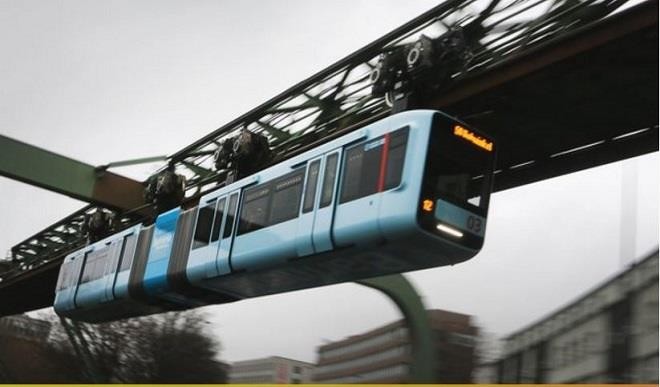
If you love riding trains, you’ve got to ride this one before you die: It’s the world’s only mass-transit rail system which has its wheels on the roof and a yawning gulf under the floor.
Is it an aerial cableway or a rollercoaster? Neither. It’s a stately suspended monorail that carries 24 million passengers a year through the German city of Wuppertal. And it has just got new, Spanish-built cars, crowning two decades of extensive track renovations.
About 85,000 passengers each workday use the overhead railway, known in German as the Schwebebahn, in the city of 350,000 people.
There are 20 stations along the one 13.3-kilometre route, 10 kilometres of which are directly over the Wupper River. The rail is 12 metres above the water and 8 metres above street level.
Opened to the public in 1901, the German city’s marvel of civil engineering may not be quite as recognizable worldwide as the Eiffel Tower or the Golden Gate Bridge, but has always been celebrated in souvenirs.
It is pictured on coffee mugs and ballpoint pens, not to mention embodied in wine gums and cookie cutters.
Costing 634 million Euros (about 672 million US dollars) in all, the renovations involved stations as well as the railway’s massive supporting framework. Because the monorail remained in operation and its uniqueness made customization necessary, the work took longer than might have been expected.
The most serious accident in the railway’s history occurred in 1999 in the midst of structural work. A piece of metal left on the rail by the construction company caused a train to derail and fall into the river. Five passengers were killed and 47 injured.
Today, though, the mood is festive following the mid-December debut of the first five new sky-blue cars built in Spain. All 31 new cars are to be in operation by early 2018, which will speed up service and allow trains to leave stations every two minutes.
"We’re excited and happy, and everyone else is happy too," said Holger Stephan, spokesman for Wuppertal’s department of public works.
While the new cars are the same size as the old ones, they’re roomier inside and have space for prams and wheelchair users. And the seats, unlike the old ones, are upholstered.
More than 1,700 toy cars modelled after the new version have already been sold, adding to the plethora of Schwebebahn merchandise.
Most of the cars taken out of service have been sold to monorail aficionados.
An industrial centre in western Germany, Wuppertal city was formed in 1929 from the merger of the cities of Barmen and Elberfeld along with several other adjoining communities.
At the end of the 19th century, officials in Barmen and Elberfeld chose the unusual option of an elevated rather than underground railway because the ground in their cities was very densely built up, and decided the lightest track along the river would need just one rail.
In 1900, several months before the monorail’s official opening, German Kaiser Wilhelm II and his consort, Auguste Viktoria, took a ride on the newfangled mode of public transport.
An "imperial car" from the initial production series is still used for special excursions.
But the most famous passenger was a young elephant named Tuffi, who had a short ride in 1950 as a publicity stunt for a circus. The swaying vehicle agitated the animal, and it jumped out of the moving train and into the Wupper River.
Tuffi survived with a scrape on its backside, and Wuppertal’s suspended monorail became a story richer. (DPA)

 Join Daily Trust WhatsApp Community For Quick Access To News and Happenings Around You.
Join Daily Trust WhatsApp Community For Quick Access To News and Happenings Around You.


